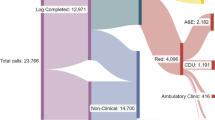Abstract
Objectives
In 2010, St. James Institute of Oncology (Leeds, UK) created a new acute oncology service (AOS) consisting of a new admissions unit with a nurse-led telephone triage (TT) system. This audit cycle (March 2011 and June 2013) evaluated patient experiences of the reconfigured AOS and staff use of the TT system.
Methods
Patient views were elicited via a questionnaire and semi-structured interviews. The TT forms were analysed descriptively evaluating completion and data quality, reported symptoms and their severity and advice given (including admission rates).
Results
Patients (n = 40) reported high satisfaction with the new AOS. However, 56 % of patients delayed 2 days or more before contacting the unit. In 2011, 26 % of all the admitted patients were triaged via the TT system; 133 TT forms were completed. In June 2013, 49 % of the admitted patients were triaged; 264 forms were completed. The most commonly reported symptoms on the TT forms were pain, pyrexia/rigors/infection, diarrhoea, vomiting and dyspnoea. Half of the patients using the TT system were admitted (52 % in 2011, 49 % in 2013).
Conclusions
Our audit provided evidence of successful implementation of the TT system with the number of TT forms doubling from 2011 to 2013. The new AOS was endorsed by patients, with the majority satisfied with the care they received.


Similar content being viewed by others
References
Delgado-Guay, MO, Kim, YJ, Shin, SH, Chisholm, G, Williams, J, Allo, J, Bruera, E (2014) Avoidable and unavoidable visits to the emergency department among patients with advanced cancer receiving outpatient palliative care. J Pain Symptom Manag 49:497–504
Marshall E, Young A, Clark P, Selby P (2014) Problem solving in acute oncology. Clinical Publishing, Oxford
National Audit Office (2010) Delivering the cancer reform strategy: Department of Health, House of Commons papers 568 2010-11. Retrieved from https://www.nao.org.uk/report/delivering-the-cancer-reform-strategy
National Cancer Action Team (2011) National Cancer Peer Review Programme Manual for Cancer Services: Chemotherapy Measures. Retrieved from https://www.cquins.nhs.uk/download.php?d=resources/measures/Chemotherapy
National Chemotherapy Advisory Group, for the Department of Health (2009) Chemotherapy Services in England: Ensuring quality and safety. Retrieved from https://webarchive.nationalarchives.gov.uk/20130107105354/http:/.../dh_104501
National Confidential Enquiry into Patient Outcome and Death (2008) For better, for worse? A review of the care of patients who died within 30 days of receiving systemic anti-cancer therapy. Retrieved from http://www.ncepod.org.uk/2008report3/Downloads/SACT_report
Nirenberg A, Mulhearn L, Lin S, Larson E (2004) Emergency department waiting times for patients with cancer with febrile neutropenia: a pilot study. Oncol Nurs Forum 31:711–715
Royal College of Physicians and Royal College of Radiologists (2012) Cancer patients in crisis: responding to urgent needs. Report of a working party. Retrieved from https://www.rcr.ac.uk/publication/cancer-patients-crisis-responding-urgent-needs
Swenson KK, Rose MA, Ritz L, Murray CL, Adlis SA (1995) Recognition and evaluation of oncology-related symptoms in the emergency department. Ann Emerg Med 26:12–17
Tsai SC, Liu LN, Tang ST, Chen JC, Chen ML (2010) Cancer pain as the presenting problem in emergency departments: incidence and related factors. Support Care Cancer 18:57–65
UK Oncology Nursing Society (2010) Oncology/haemotology 24 hour triage rapid assessment and access toolkit evaluation. Retrieved from http://connect.qualityincare.org/oncology/patient_safety/case_studies/the_ukons_oncologyhaematology_-_24_hour_triage_-_rapid_assessment_and_access_tool_kit#evaluation
Acknowledgments
The authors would like to thank Dr. Geoff Hall, Dr. Alison Young and all AOS staff for their cooperation and support.
This work was carried out as part of the eRAPID Development Grant RP-DG-1209-10031; ISCTRN trial number CCT-NAPN-21338, funded by the National Institute for Health Research (NIHR).
Author information
Authors and Affiliations
Corresponding author
Ethics declarations
Conflict of interest
The authors declare that they have no conflict of interest.
Additional information
Lucy Ziegler and Galina Velikova are Joint senior authors
Rights and permissions
About this article
Cite this article
Warrington, L., Holch, P., Kenyon, L. et al. An audit of acute oncology services: patient experiences of admission procedures and staff utilisation of a new telephone triage system. Support Care Cancer 24, 5041–5048 (2016). https://doi.org/10.1007/s00520-016-3370-4
Received:
Accepted:
Published:
Issue Date:
DOI: https://doi.org/10.1007/s00520-016-3370-4



